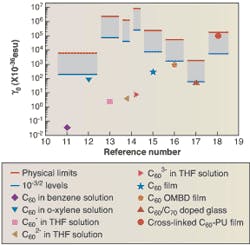NONLINEAR MATERIALS: Optical-switching material breaches quantum gap
Scientists at the University of Toronto (Toronto, Ont., Canada) and Carleton University (Ottawa, Ont., Canada) have demonstrated the first material that approaches fundamental limits for nonlinear optical response. According to project leader Edward Sargent of the University of Toronto, the result is switching times of a picosecond (10 to 100 times faster than electronic switching) at wavelengths across the entire range used for telecommunications. Further, says Sargent, the material meets engineering figures of merit that stipulate the conditions for index versus absorption. This work exploits recent developments in the understanding of the interaction between matter and light, and is the first to push past an apparent limit (that has held for all other materials) toward the fundamental quantum-mechanical limit.
Sargent sees this shift in the speed and sensitivity of optical switches as being the first step toward a new generation of photonic networks in which light not only carries the data and routing information, but also directly controls the switches in its path. All-optical switches have been used in niche applications for some time despite being relatively slow and insensitive: the fact that they do not require optoelectronic conversion and regeneration steps is already a significant advantage where high bandwidth is needed and slow routing is acceptable. The new material, and those that follow, should make all-optical networks possible more generally and allow them to operate up to two orders of magnitude faster than is possible today. The work is sponsored, among others, by Nortel Networks (Brampton, Ont., Canada).
The traditional way of designing nonlinear materials is to develop individual molecules with two properties. The first is a high first-excited-state energy to stop energy from being dissipated through many small transitions. This property doesn’t vary much between molecules. The second is a large number of electrons: the more there are to move around the molecule, the better the response will be. Mark Kuzyk of Washington State University (Pullman, WA) has studied the quantum mechanics of these issues and published the fundamental physical limits that result.1 He says that one of the problems with this approach is that only a single molecule is considered. More molecules can be added for more response, but if the molecules are connected to make a larger one with more electrons, the response is multiplied.
Crosslinking molecules
Sargent and his team did exactly that-they started with responsive carbon C60 molecules and then crosslinked them in a polyurethane film.2 The results of this strategy were dramatic. Some previous formulations using C60 had come close to an apparent limit: a curve based on measurements of the best materials over many years indicated a factor of 10-3/2 smaller than what was theoretically possible within quantum mechanics. The new film, however, made it into the so-called “quantum gap” separating these levels (see figure). In fact, the response parameter they used (second hyperpolarizability) was 17 times higher than the apparent limit, and 55% of the fundamental.
“What is significant about the work is that it shows that if you take a bunch of good molecules and connect them together, they can act together in a way that makes a great material in which the whole is greater than the sum of its parts,” says Kuzyk. “There are lots of very fine chemists who have put a substantial amount of work into making better and better molecules. Nevertheless, from the fundamental physics perspective, there has been almost no gain in the performance of materials over the last 20 years. In the case of Sargent’s work, he and his chemistry collaborators have introduced a new paradigm that focuses on connecting molecules together rather than on trying to make better molecules. This is the kind of approach that is needed because making interacting systems is the only approach that remains for making better bulk materials.”
REFERENCES
- K. Tripathy et al., J. Chem. Phys. 121(15), 15 (October 2004).
- Qiying Chen et al., Nano Letters 4(9) (2004).
Sunny Bains | Contributing Editor
Sunny Bains is a contributing editor for Laser Focus World and a technical journalist based in London, England.
